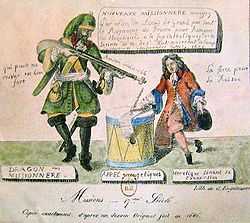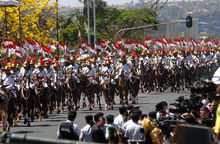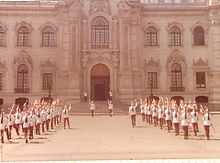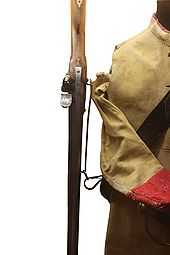Dragoon

The name is possibly derived from a type of firearm (called a dragon) carried by dragoons of the French Army. There is no distinction between the words dragon and dragoon in French; both are referred to as dragon.
The title has been retained in modern times by a number of armoured or ceremonial mounted regiments.
The word also means to subjugate or persecute by the imposition of troops; and by extension to compel by any violent measures or threats. The verb dates from 1689, at a time when dragoons were being used by the French monarchy to persecute Protestants.[1]
Origins and name


The establishment of dragoons evolved from the practice of sometimes transporting infantry by horse when speed of movement was needed. An early instance was ordered by Louis of Nassau during operations near Mons in Hainaut, when 500 infantry were transported this way.[2] In 1552 Prince Alexander of Parma mounted several companies of infantry on pack horses to achieve surprise.[2] It is also suggested the first dragoons were raised by the Marshal de Brissac in 1600.[3] According to old German literature, dragoons were invented by Count Ernst von Mansfeld, one of the greatest German military commanders, in the early 1620s. There are other instances of mounted infantry predating this. However Mansfeld, who had learned his profession in Hungary and the Netherlands, often used horses to make his foot troops more mobile, creating what was called an "armée volante" (French for flying army).
The name possibly derives from an early weapon, a short wheellock called a dragon because the first dragoons raised in France had their carbine's muzzle decorated with a dragon's head. The practice comes from a time when all gunpowder weapons had distinctive names, including the culverin, serpentine, falcon, falconet, etc.[4] It is also sometimes claimed a galloping infantryman with his loose coat and the burning match resembled a dragon.[5]
Early history and role
Early dragoons were not organized in squadrons or troops as were cavalry, but in companies like the infantry: their officers and non-commissioned officers bore infantry ranks. Dragoon regiments used drummers, not buglers, to communicate orders on the battlefield. The flexibility of mounted infantry made dragoons a useful arm, especially when employed for what would now be termed "internal security" against smugglers or civil unrest, and on line of communication security duties. During the English Civil War dragoons were used for a variety of tasks: providing outposts, holding defiles or bridges in the front or rear of the main army, lining hedges or holding enclosures, and providing dismounted musketeers to support regular cavalry.[6] Supplied with inferior horses and more basic equipment, the dragoon regiments were cheaper to recruit and maintain than the expensive regiments of cavalry. When in the 17th century Gustav II Adolf introduced dragoons into the Swedish Army, he provided them with a sabre, an axe and a matchlock musket, utilizing them as "labourers on horseback".[7] Many of the European armies henceforth imitated this all-purpose set of weaponry.
A non-military use of dragoons was the 1681 Dragonnades, a policy instituted by Louis XIV to intimidate Huguenot families into either leaving France or re-converting to Catholicism by billeting ill-disciplined dragoons in Protestant households.
However, dragoons were at a disadvantage when engaged against true cavalry, and constantly sought to improve their horsemanship, armament and social status. By the Napoleonic Wars the primary role of dragoons in most European armies had progressed from that of mounted infantry to that of medium cavalry. Earlier dragoon responsibilities for scouting and picket duty had passed to hussars and similar light cavalry corps in the French, Austrian, Prussian, and other armies. In the Imperial Russian Army, due to the availability of the cossack troops, the dragoons were retained in their original role for much longer.
An exception to the rule was the British Army. To reduce military budgets all horse (cavalry) regiments were gradually demoted to dragoons from 1746 onward — which meant they were paid on a lower scale. When this was completed in 1788, the heavy cavalry regiments had become either Dragoon Guards or Heavy Dragoons (depending on their precedence). The designation of Dragoon Guards did not mean that these regiments (the former 2nd to 8th Horse) had become Household Troops, but simply that they had been given a more dignified designation to compensate for the loss of pay and prestige.[8] Starting in 1756, seven regiments of Light Dragoons were raised. These Light Dragoons were trained in reconnaissance, skirmishing and other work requiring endurance in accordance with contemporary standards of light cavalry performance. The success of this new class of cavalry was such that that eight regular Dragoon regiments were converted to Light Dragoons between 1768 and 1783.[9]

19th century
During the Napoleonic Wars, dragoons generally assumed a cavalry role, though remaining a lighter class of mounted troops than the armored cuirassiers. Dragoons rode larger horses than the light cavalry and wielded straight, rather than curved swords. Emperor Napoleon often formed complete divisions out of his 20 to 30 dragoon regiments and used them as battle cavalry owing to shortage of cavalry mounts, to break the enemy's main resistance.[10] In 1809, French dragoons scored notable successes against Spanish armies at the Battle of Ocana and the Battle of Alba de Tormes. British heavy dragoons made devastating charges against French infantry at the Battle of Salamanca in 1812 and at the Battle of Waterloo in 1815.
In the Spanish army, in 1635, Pedro de la Puente organized in Innsbruck (Austria) a body of dragoons, and in 1640 one was created in Spain as a tercio of a thousand dragoons armed with the arqabus. In 1704 like the rest of the tercios, the Spanish dragoons were reorganised into regiments by Felipe V. During the 18th century several additional regiments of dragoons were created in the Spanish Americas, some of them to function as a police force. In 1803 the regiments of dragoons began to be called light cavalry and shortly after 1815 this class of cavalry disappeared from the Spanish Army. However three regiments of Spanish dragoons had been reestablished by the 1880s and these continued in existence until the overthrow of the Monarch in 1931.
In several stages between 1816 and 1861, the 21 existing Light Dragoon regiments in the British Army were disbanded or converted to lancers or hussars.[11]
Between 1881 and 1910 all Russian cavalry (other than Cossacks and Imperial Guard regiments) were designated as dragoons, reflecting an emphasis on dismounted action in their training and a growing acceptance of the impracticality of employing historical cavalry tactics against modern firepower.

In Japan, in the late 19th century/early 20th century, dragoons were deployed in the same way as in other armies, but were dressed as hussars.
20th century
In 1914 there were still dragoon regiments in the British, French, German, Russian, Austro-Hungarian, Peruvian, Norwegian, Swedish, Danish and Spanish armies. Their uniforms varied greatly, lacking the characteristic features of hussar or lancer regiments. There were occasional reminders of the mounted infantry origins of this class of soldier. Thus the dragoon regiments of the Imperial German Army wore the pickelhaube (spiked helmet) of the same design as those of the infantry and the British dragoons wore scarlet tunics,[12] In other respects however dragoons had adopted the same tactics, roles and equipment as other branches of the cavalry and the distinction had become simply one of traditional titles.
The historic Geman, Russian and Austro-Hungarian dragoon regiments ceased to exist as distinct branches following the overthrow of the respective Imperial regimes of these countries during 1917-18. The Spanish dragoons, which dated back to 1640, were reclassified as numbered cavalry regiments in 1931 as part of the army modernization policies of the new Republic
The Australian Light Horse were similar to dragoon regiments in many regards, being mounted infantry which normally fought on foot, their horses' purpose being transportation. They served during the Second Boer War and World War I. The Australian 4th Light Horse Brigade became famous for the Battle of Beersheba in 1917 where they charged on horseback using rifle bayonets, since neither sabres or lances were part of their equipment.
Probably the last use of real dragoons (infantry on horseback) in combat was made by the Portuguese Army in the war in Angola during the 1960s and early 1970s. In 1966, the Portuguese created an experimental horse platoon, to operate against the guerrillas in the high grass region of the Eastern Angola, in which each soldier was armed with a G3 assault rifle to combat on foot and with an automatic pistol to fire on horseback. The troops on horseback were able to operate in difficult terrain (unsuited for motor vehicles) and had the advantage of being able to control the area around them, with a clear view over the grass (which foot troops didn't have). Moreover, these unconventional troops created a psychological impact over the enemy, which was not used to dealing with horse troops, having no training or strategy to face them. The experimental horse platoon was so successful that its entire parent battalion was transformed from an armored reconnaissance unit to a three squadron horse battalion known as the "Dragoons of Angola". One of the typical operations carried out by the Dragoons of Angola, in cooperation with airmobile forces, consisted of the dragoons chasing the guerrillas and pushing them in one direction, with the airmobile troops being launched from helicopter in the enemy rear, trapping the enemy between the two forces.[13]
Modern dragoons
Brazil

The Brazilian president's honor guard is provided (amongst other units) by a regiment of dragoons: the 1st Guards Cavalry Regiment.
This regiment is known as the "Dragões da Independência" (Dragoons of Independence). The name was given in 1927 and refers to the fact that a detachment of dragoons escorted the Prince Royal of Portugal, Pedro I, at the time when he declared Brazilian independence from Portugal, on September 7, 1822.
The Independence Dragoons wear 19th century uniforms similar to those of the earlier Imperial Honor Guard. The uniform was designed by Debret, in white and red, with plumed bronze helmets. The colors and pattern were influenced by the Austrian dragoons of the period, as the Brazilian Empress Consort was also an Austrian Archduchess.[14] The color of the plumes varies according to rank. The Independence Dragoons are armed with lances.[15]
The regiment was established in 1808 by the Prince Regent and future king of Portugal, John VI, with the duty of protecting the Portuguese royal family, which had sought refuge in Brazil during the Napoleonic wars. However dragoons had existed in Portugal since at least the early 18th century and, in 1719, units of this type of cavalry were sent to Brazil, initially to escort shipments of gold and diamonds and to guard the Viceroy who resided in Rio de Janeiro (1st Cavalry Regiment – Vice-Roy Guard Squadron). Later, they were also sent to the south to serve against the Spanish during frontier clashes. After the proclamation of Brazilian independence, the title of the regiment was changed to that of the Imperial Honor Guard, with the role of protecting the Imperial Family. The Guard was later disbanded by Emperor Peter II and would be recreated only later in the republican era.[16]
At the time of the Republic proclamation in 1889, horse #6 of the Imperial Honor Guard was ridden by the officer making the declaration. This is commemorated by the custom under which the horse having this number is used only by the commander of the modern regiment.
Canada

There are three dragoon regiments in the Canadian Forces: the Royal Canadian Dragoons and two reserve regiments, the British Columbia Dragoons and the Saskatchewan Dragoons. The Royal Canadian Dragoons is the senior Armoured regiment in the Canadian Forces. The current role of The Royal Canadian Dragoons is to provide Armour Reconnaissance support to 2 Canadian Mechanized Brigade Group (2 CMBG) operations.
The Royal Canadian Mounted Police were accorded the formal status of a regiment of dragoons in 1921.[17][18] The modern RCMP does not retain any military status however.
Chile
Founded as the Dragones de la Reina (Queen's Dragoons) in 1758 and later renamed the Dragoons of Chile in 1812, and then becoming the Carabineros de Chile in 1903. The Carabineros are the national police of Chile. The military counterpart, that of the 15th Reinforced Regiment "Dragoons" is now as of 2010 the 4th Armored Brigade "Chorrillos" based in Punta Arenas as the 6th Armored Cavalry Squadron "Dragoons", and form part of the 5th Army Division
Denmark
The Royal Danish Army includes amongst its historic regiments the Jutish Dragoon Regiment, which was raised in 1670.
Finland
The Finnish Dragoon squadron exists in conjunction with the Army Academy in Lappeenranta and continues the tradition of the former 1. Squadron of the Uusimaa Dragoon battalion.
France
The modern French Army retains three Dragoons regiments from the 32 it possessed at the beginning of World War I: the 2nd, which is a nuclear, bacteriologic and chemical protection regiment, the 4th, an armour regiment equipped with Leclerc tanks, and the 13th, which is a special-ops parachute regiment.
Norway
In the Norwegian Army during the early part of the 20th century, dragoons served in part as mounted troops, and in part on skis or bicycles (hjulryttere, meaning "wheel-riders"). Dragoons fought on horses, bicycles and skis against the German invasion in 1940. After World War II the dragoon regiments were reorganized as armoured reconnaissance units. "Dragon" is the rank of a compulsory service private cavalryman while enlisted (regular) cavalrymen have the same rank as infantrymen: "Grenader".
Peru

The Dragoon Guards of the “Field Marshal Domingo Nieto” Life-Guard Escort Cavalry Regiment of the President of the Republic of Perú were the traditional Guard of the Government Palace of Perú until March 5, 1987 and disbandment in that year. However by Ministerial Resolution No 139-2012/DE/EP of February 2, 2012 the restoration of the Cavalry Regiment "Marshal Domingo Nieto" as the official escort of the President of the Republic of Peru was announced. The main mission of the reestablished regiment was to guarantee the security of the President of the Republic and of the Government Palace.
This regiment of dragoons was created in 1904 following the suggestion of a French military mission which undertook the reorganization of the Peruvian Army in 1896. The initial title of the unit was Cavalry Squadron "President's Escort". It was modeled on the French dragoons of the period. The unit was later renamed as the Cavalry Regiment "President's Escort" before receiving its current title in 1949.
The Peruvian Dragoon Guard has throughout its existence worn French-style uniforms of black tunic and red breeches in winter and white coat and red breeches in summer, with red and white plumed bronze helmets with the coat of arms of Peru and golden epaulettes. They retain their original armament of lances, sabres, and rifles.
At 13:00 hours every day, the main esplanade in front of the Government Palace of Perú fronting Lima's Main Square serves as the stage for the changing of the guard, undertaken by members of the Presidential Life Guard Escort Dragoons, mounted or dismounted.
Portugal
The Portuguese Army still maintains two units which are descended from former regiments of dragoons. These are the 3rd Regiment of Cavalry (the former "Olivença Dragoons") and the 6th Regiment of Cavalry (the former "Chaves Dragoons"). Both regiments are, presently, armoured units. The Portuguese Rapid Reaction Brigade' Armoured Reconnaissance Squadron – a unit from the 3rd Regiment of Cavalry – is known as the "Paratroopers Dragoons".
During the Portuguese Colonial War in the 1960s and the 1970s, the Portuguese Army created an experimental horse platoon, to combat the guerrillas in eastern Angola. This unit was soon augmented, becoming a group of three squadrons, known as the "Angola Dragoons". The Angola Dragoons operated as mounted infantry – like the original dragoons – each soldier being armed with a pistol to fire when on horseback and with an automatic rifle, to use when dismounted. A unit of the same type was being created in Mozambique when the war ended in 1974.
Sweden
In the Swedish Army, dragoons comprise the Military Police and Military Police Rangers. They also form the Dragoons Battalion of the Life Guards. The Dragoons Battalion have roots that go back as far as 1523, making it one of the world's oldest military units still in service and the only mounted unit still retained by the Swedish Army. Horses are used for ceremonial purposes only, most often when the dragoons take part in the changing of the guards at The Royal Palace in Stockholm. "Livdragon" is the rank of a private cavalryman. The dragon battalions remaining in Sweden are what today train and service the special forces units.
Switzerland

In the Swiss Army, mounted dragoons existed until the early 1970s, when they were converted into Armoured Grenadiers units. The "Dragoner" had to prove he was able to keep a horse at home before entering the army. At the end of basic training they had to buy a horse at a reduced price from the army and to take it home together with equipment, uniform and weapon. In the "yearly repetition course" the dragoons served with their horses, often riding from home to the meeting point.
The abolition of the dragoon units, believed to be the last non-ceremonial horse cavalry in Europe, was a contentious issue in Switzerland. On 5 December 1972 the Swiss National Council approved the measure by 91 votes, against 71 for retention.[19]
United Kingdom
As many as thirty one regiments were in existence at the height of the Napoleonic Wars (regiments: 7 Dragoon Guard - 1st to 7th, 5 Dragoon - 1st to 6th (5th Dragoons disbanded for mutiny), 19 Light Dragoon - 7th to 25th).
In the present-day British Army regular army, four regiments are designated as dragoons:
- 1st The Queen's Dragoon Guards
- Royal Scots Dragoon Guards
- Royal Dragoon Guards
- The Light Dragoons
The three regiments named as Dragoon Guards were historically considered heavy cavalry, although by continental standards they were not the heaviest type of cavalry since they carried no armour (unlike cuirassiers). The designation "Dragoon Guards" does not indicate the status of Household Troops but is a distinction awarded to former "Regiments of Horse" when these were converted to Dragoons in 1746.
The Light Dragoons were formed as light cavalry during the Napoleonic Wars, and were similar to hussars. In the early 19th century several regiments were simultaneously designated as light dragoons and as hussars.
In the Territorial Army, one of the five squadrons of the Royal Yeomanry is designated as dragoons: The Westminster Dragoons.
United States

Towards the end of 1776 George Washington realized the need for a mounted branch of the military. In January 1777 four regiments of light dragoons were raised. Short term enlistments were abandoned and the Dragoons joined for three years, or "the war." They participated in most of the major engagements of the war, including the Battles of White Plains, Trenton, Princeton, Brandywine, Germantown, Saratoga, Cowpens, and Monmouth, as well as the Yorktown campaign.
The 1st United States Dragoons explored Iowa after the Black Hawk Purchase put the area under U.S. control. In the summer of 1835, the regiment blazed a trail along the Des Moines river and established outposts from present-day Des Moines to Fort Dodge. In 1933, the State of Iowa opened the Dragoon Trail, a scenic and historic drive that follows the path of the 1st United States Dragoons on their historic march.
In 1861 the two existing U.S. Dragoon regiments were re-designated as the 1st and 2nd Cavalry. This reorganization did not affect their role or equipment, although the traditional orange uniform braiding of the dragoons was replaced by the standard yellow of the Cavalry branch. This marked the official end of dragoons in the U.S. Army, although certain modern units trace their origins back to the historic dragoon regiments.
The 1st and 2nd Battalion, 48th Infantry were mechanized infantry units assigned to the 3rd Armored Division (3AD) in West Germany during the Cold War. The unit crest of the 48th Infantry designated the unit as Dragoons.
The 1st Dragoons was reformed in the Vietnam era as the 1st Squadron, 1st U.S. Cavalry. It has served in the Iraqi War and remains as the oldest cavalry unit, as well as the most decorated one, in the U.S. Army. Today's modern 1–1 Cavalry is a scout/attack unit, equipped with MRAPs, M3A3 Bradley CFVs, and Strykers.[citation needed]
Another modern United States Army unit informally known as the 2nd Dragoons, is the 2nd Stryker Cavalry Regiment. This unit was originally organized as the Second Dragoon Regiment in 1836 and was renamed the Second Cavalry Regiment in 1860, being redesignated as the 2nd Armored Cavalry Regiment in the 1960s. The regiment is currently equipped with the Stryker family of wheeled fighting vehicles. The 2nd Stryker Cavalry Regiment also has the distinction of being the longest continuously serving unit in the United States Army.
See also
Citations and notes
- ↑ Online Etymology Dictionary | Etymology of Words & Word Origins | Dictionary.com
- ↑ 2.0 2.1 p.330, Bismark
- ↑ p.331, Bismark
- ↑ p.333, Bismark
- ↑ p. 48, A Dictionary of Military Uniform W. Y. Carman ISBN 0-684-15130-8
- ↑ Peter Young & Richard Holmes, page 42 "The English Civil War", ISBN 1-84022-222-0
- ↑ Richard Brzezinski, page 16 "The Army of Gustavus Adolphus 2 - ", ISBN 1-85532-350-8
- ↑ Michael Barthorp, page 22 "British Cavalry Uniforms Since 1660", ISBN 0-7137-1043-8
- ↑ page 24 "British Cavalry Uniforms Since 1660", Michael Barthorp, ISBN 0-7137-1043-8
- ↑ Rothenberg, p 141
- ↑ British Cavalry Uniforms Since 1660, Michael Barthorp ISBN 0-7137-1043-8
- ↑ hussars and all but one of the lancer regiments wore dark blue.
- ↑ CANN, Jonh P., "Counterinsurgency in Africa: The Portuguese Way of War, 1961-1974", Hailer Publishing, 2005
- ↑ "Exército Brasileiro - Braço Forte, Mão Amiga" (in Portuguese). Archived from the original on 2009-03-12.
- ↑ "Presidência da República - GSI" (in Portuguese). office of the president of Brazil. Archived from the original on 2008-06-21. Retrieved 2014-02-01.
- ↑ CARVALHO, José Murilo de. D. Pedro II: Ser ou não ser. São Paulo: Companhia das Letras, 2007, p.98
- ↑ "Royal Canadian Mounted Police". Archived from the original on 2008-01-18. Retrieved 2014-02-01.
- ↑ heraldist1
- ↑ "11214 BRG". National Council of SwitzerlandNational Council of Switzerland. 1972. Retrieved 2014-02-01.
References
- Rothenberg, Gunther Erich (1978). The Art of Warfare in the Age of Napoleon. Bloomington: Indiana University Press. ISBN 0253310768. LCCN 77086495. Retrieved 2014-02-01.
- von Bismark, Graf Friedrich Wilhelm (1855). On the Uses and Application of Cavalry in War from the Text of Bismark: With Practical Examples Selected from Ancient and Modern History. North Ludlow Beamish (translator). London: T. & W. Boone. Retrieved 2014-02-01.
Further reading
- Sawicki, James A. (1985). Cavalry Regiments in the U.S. Army. Dumfries, VA: Wyvern Publications. p. 415. ISBN 0960240462. LCCN 85050072.
External links
| Look up dragoon in Wiktionary, the free dictionary. |
| Wikimedia Commons has media related to Dragoons. |
| Wikisource has the text of the 1911 Encyclopædia Britannica article dragoon. |
- Napoleonic Cavalry: Dragoons, Cuirassiers
- Saskatchewan Dragoons (Canada)
- British Columbia Dragoons (Canada)
- First Regiment of Cavalry (USA)
- The Society of the Military Horse
- “Field Marshal Nieto” Regiment of Cavalry (Perú)
- Perú 1970: Changing of the Dragoon Guard